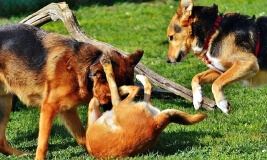 Watching dogs play together is so much fun. Many make friends
easily and thoroughly enjoy the moments spent in play ... it's
hard not to smile at their antics! But there are times when play
escalates and a dog may no longer be enjoying himself. When should
you step in and call things off? How does one recognize the
signs of bullying and
signs that your dog is uncomfortable?
Watching dogs play together is so much fun. Many make friends
easily and thoroughly enjoy the moments spent in play ... it's
hard not to smile at their antics! But there are times when play
escalates and a dog may no longer be enjoying himself. When should
you step in and call things off? How does one recognize the
signs of bullying and
signs that your dog is uncomfortable?
Bullying Behaviour
A canine 'bully' is a dog that hasn't learned appropriate dog-to-dog interactions. While some dogs are great at reading and responding to social cues, let's face it, there are dogs that simply clueless when it comes to playing with other dogs. Any breed, any age, and any size of dog, can be a bully.Signs of bullying behaviour include:
- One dog engages in chasing, pinning, or 'playing' behaviours that the other dog doesn't engage in return (dogs usually switch roles, from being the 'chaser' to the 'chased', for example);
- One dog persistently chases down the other, even when the other dogs tries to avoid interactions (ie. hiding, moving away, attempting to ignore the bullying dog, yelping or snapping to indicate that he's had enough);
- It's clear that one dog is feeling harried, uncomfortable, fearful, or is just plain not enjoying the play.
In one situation, a dog might behave like a bully, while in a different situation he might be bullied.
If you see bullying behaviour, put a stop to it immediately. The 'bully' dog should be allowed to calm down before re-engaging in play. If it escalates again, then call it a day and let the dogs try again some other time. If it's your dog that's the bully, consult with a dog behaviourist to learn how to train and manage your dog more effectively during dog-to-dog interactions. Real aggression is fortunately pretty rare, but it's always good to know how to break up a dog fight without getting hurt.
Keep in mind that any size of dog can be a bully. One of the biggest bullies we ever met was a pint-sized terrier, who was terrorizing a large shepherd mix!
Let Play Continue, or Put a Stop to It?
Sometimes it can be scary to watch (and hear!) a couple of physical dogs playing together. Dogs may growl, bite, pin each other, or knock one another about. This type of play can be unnerving to us humans!Not all 'rough' play is inappropriate. Different dogs have different play styles, and if both dogs are enjoying themselves (and not getting hurt) then let them play.
If you recall your dog and she quickly goes back to try to initiate play with the other dog, then it's okay to let them continue with their game. If, however, she tries to hide or retreat from the other dog, then it's time to end the play session.
Dog parks can be difficult places for some dogs to socialize because you can never be sure what dog will show up. Some dogs have a play 'style' that's compatible to more dogs. If your dog doesn't have a buddy (or group of buddies) that she plays well with at the dog park, then consider setting up private play dates instead.
Here's a video of inappropriate dog play, where the larger dog is too worked up and the smaller white dog is often just trying to get away. Once the woman holds the larger dog by the collar, the white dog takes the opportunity to remove himself from play, showing that he wasn't enjoying the other dog's play style.
(For a more detailed explanation, visit Dr. Sophia Yin's blog)
Here's a video of appropriate dog play... both dogs having lots of fun, responding to cues and taking breaks so that they don't get too worked up.
Signs of Stress
Dogs use body-language to convey their stress. Watch for signs like:
- Licking of the nose or lips (in the absence of food);
- Yawning;
- Sudden and/or frantic sniffing of the ground as another dog approaches;
- Avoiding eye contact or turning away;
- Avoidance or backing away from the other dog;
- Panting, if the dog hasn't been engaging in exercise or it's a cool day;
- Tension around the eyes or mouth area (for example, a stress-panting dog suddenly closes it mouth) or 'freezing' in place;
- Low body posture - slinking, tail held low or in-between the legs, or head held low may all be examples of stress;
- Laying ears back against the head can sometimes be a sign of stress, especially when combined with other signs like tension around the mouth. However, some dogs lay their ears back against their heads and aren't at all stressed - you can see this with other signs, for example, a relaxed & open mouth.
We love to see dogs playing together, but some dogs simply don't enjoy it. They may never come to enjoy it, either, and that's okay. Some dogs enjoy playing with select others but aren't good candidates for dog parks where there are many dogs with a variety of play styles. You know your dog best, so if you see something that is making your dog uncomfortable, then put a stop to it. There is nothing wrong with a dog who prefers to enjoy a peaceful walk with its owner, without interacting with other dogs. Play safe!
"The most affectionate creature in the world is a wet dog." (Ambrose Bierce)
Comments (0)